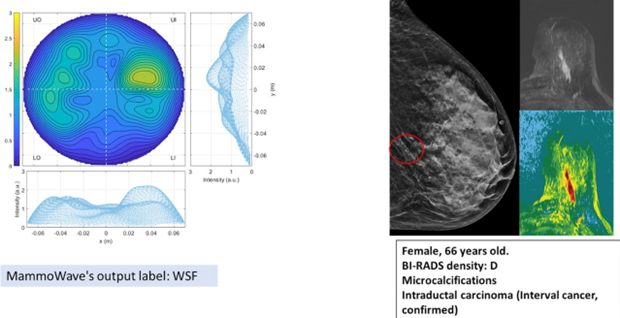MammoWave®, the technology being evaluated in the MammoScreen Project, uses microwave signals rather than X-rays to detect breast abnormalities. It operates in the 1 – 9 GHz frequency range and is non-invasive, does not emit ionizing radiation and requires no breast compression, making it safer and more comfortable for patients compared to traditional mammography.
The device utilizes ultra-wideband (UWB) signals to differentiate between healthy and malignant tissues based on their dielectric properties, which can be understood as the way a material stores and transmits electric energy. It works in the detection of cancer, because every material – including human tissue – reacts differently when exposed to electromagnetic waves. Preliminary studies have shown that MammoWave® can detect subtle differences between normal tissue and cancer and MammoScreen is testing the device on a larger scale to gather further supporting evidence. The output of a MammoWave® scan is not a conventional image. Instead, it is a graphical representation of how tissue affects microwave signals. These patterns form the basis of a unique type of report that includes 2D images showing variations in tissue properties as shown in the diagram below, as well as a summary of dielectric measurements across different breast regions and an AI-based risk assessment, indicating whether the scan appears normal or if suspicious findings need further investigation.

According to the protocol of our clinical study, if the AI label indicates a suspicion of malignancy, an additional ultrasound is performed to further investigate a potential abnormality, with particular attention devoted in the case of dense breast tissue. The healthcare professional will consider additional factors, such as previous imaging results, clinical symptoms, and patient history, to arrive at a final assessment.
MammoWave® provides a new tool for early breast cancer detection that prioritizes patient comfort and safety and MammoScreen is collecting data to support its clinical validation. The strategy of combining AI and non-ionizing microwave imaging represents a departure from traditional mammography assessment methods that, we hope, will be an important step towards more accessible, inclusive and accurate breast cancer screening.




